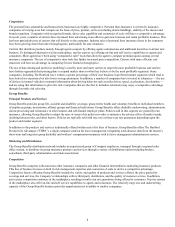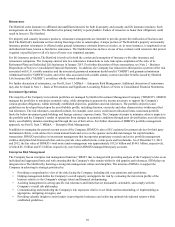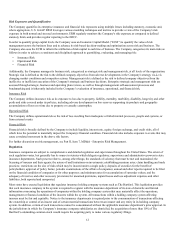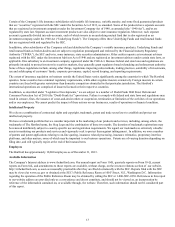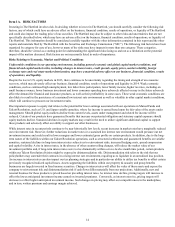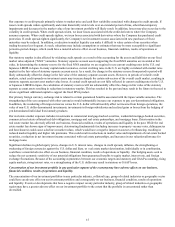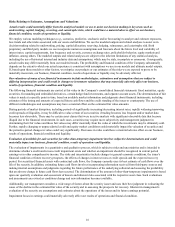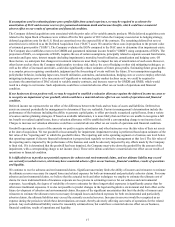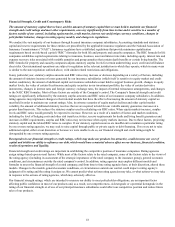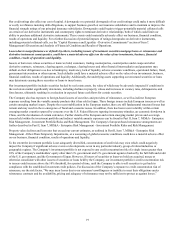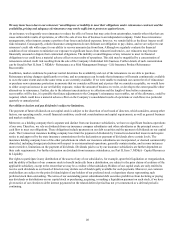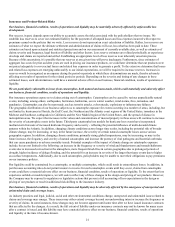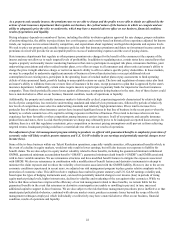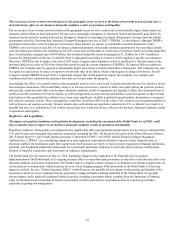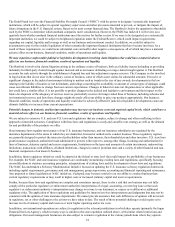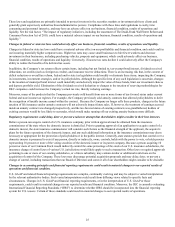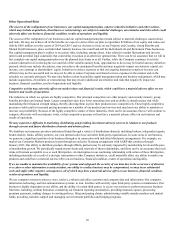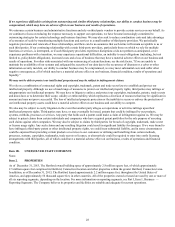The Hartford 2013 Annual Report Download - page 18
Download and view the complete annual report
Please find page 18 of the 2013 The Hartford annual report below. You can navigate through the pages in the report by either clicking on the pages listed below, or by using the keyword search tool below to find specific information within the annual report.18
Financial Strength, Credit and Counterparty Risks
The amount of statutory capital that we have, and the amount of statutory capital that we must hold to maintain our financial
strength and credit ratings and meet other requirements, can vary significantly from time to time and is sensitive to a number of
factors outside of our control, including equity market, credit market, interest rate and foreign currency conditions, changes in
policyholder behavior, changes in rating agency models, and changes in regulations.
We conduct the vast majority of our business through licensed insurance company subsidiaries. Accounting standards and statutory
capital and reserve requirements for these entities are prescribed by the applicable insurance regulators and the National Association of
Insurance Commissioners (“NAIC”). Insurance regulators have established regulations that provide minimum capitalization
requirements based on risk-based capital (“RBC”) formulas for both life and property and casualty companies. The RBC formula for life
companies establishes capital requirements relating to insurance, business, asset and interest rate risks, including equity, interest rate and
expense recovery risks associated with variable annuities and group annuities that contain death benefits or certain living benefits. The
RBC formula for property and casualty companies adjusts statutory surplus levels for certain underwriting, asset, credit and off-balance
sheet risks. Our international operations are subject to regulation in the relevant jurisdiction in which they operate, which in many ways
is similar to the state regulation outlined above, with similar related restrictions and obligations.
In any particular year, statutory surplus amounts and RBC ratios may increase or decrease depending on a variety of factors, including
the amount of statutory income or losses generated by our insurance subsidiaries (which itself is sensitive to equity market and credit
market conditions), the amount of additional capital our insurance subsidiaries must hold to support business growth, changes in equity
market levels, the value of certain fixed-income and equity securities in our investment portfolio, the value of certain derivative
instruments, changes in interest rates and foreign currency exchange rates, the impact of internal reinsurance arrangements, and changes
to the NAIC RBC formulas. Most of these factors are outside of the Company's control. The Company's financial strength and credit
ratings are significantly influenced by the statutory surplus amounts and RBC ratios of our insurance company subsidiaries. In addition,
rating agencies may implement changes to their internal models that have the effect of increasing the amount of statutory capital we
must hold in order to maintain our current ratings. Also, in extreme scenarios of equity market declines and other capital market
volatility, the amount of additional statutory reserves that we are required to hold for our variable annuity guarantees increases at a
greater than linear rate. This reduces the statutory surplus used in calculating our RBC ratios. When equity markets increase, surplus
levels and RBC ratios would generally be expected to increase. However, as a result of a number of factors and market conditions,
including the level of hedging costs and other risk transfer activities, reserve requirements for death and living benefit guarantees and
increases in RBC requirements, surplus and RBC ratios may not increase when equity markets increase. Due to these factors, projecting
statutory capital and the related RBC ratios is complex. If our statutory capital resources are insufficient to maintain a particular rating
by one or more rating agencies, we may seek to raise capital through public or private equity or debt financing. If we were not to raise
additional capital, either at our discretion or because we were unable to do so, our financial strength and credit ratings might be
downgraded by one or more rating agencies.
Downgrades in our financial strength or credit ratings, which may make our products less attractive, could increase our cost of
capital and inhibit our ability to refinance our debt, which would have a material adverse effect on our business, financial condition,
results of operations and liquidity.
Financial strength and credit ratings are important in establishing the competitive position of insurance companies. Rating agencies
assign ratings based upon several factors. While most of the factors relate to the rated company, some of the factors relate to the views of
the rating agency (including its assessment of the strategic importance of the rated company to the insurance group), general economic
conditions, and circumstances outside the rated company's control. In addition, rating agencies may employ different models and
formulas to assess the financial strength of a rated company, and from time to time rating agencies have, at their discretion, altered these
models. Changes to the models, general economic conditions, or circumstances outside our control could impact a rating agency's
judgment of its rating and the rating it assigns us. We cannot predict what actions rating agencies may take, or what actions we may take
in response to the actions of rating agencies, which may adversely affect us.
Our financial strength ratings, which are intended to measure our ability to meet policyholder obligations, are an important factor
affecting public confidence in most of our products and, as a result, our competitiveness. A downgrade or a potential downgrade in the
rating of our financial strength or of one of our principal insurance subsidiaries could affect our competitive position and reduce future
sales of our products.


